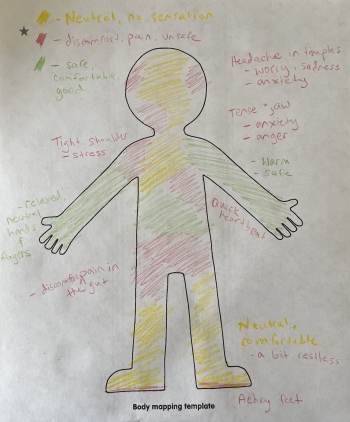
Our bodies hold stories — of stress, safety, pleasure, and everything in between.
Sometimes they tell those stories through sensations long before our minds can find words. Learning to listen to your body can be a powerful act of care in reconnecting with yourself, especially if you live with anxiety, struggle with embodiment, or are exploring your sense of safety and pleasure.
Two gentle practices that help bridge that connection are body scanning and body mapping. These tools help you slow down, notice what’s happening inside, and visualize how your body is holding your experiences — all without judgment.
What Is Body Scanning?
A body scan is a mindfulness technique that involves moving your attention slowly through your body — from the top of your head down to your toes — while noticing any sensations you find along the way. It’s not about analyzing or judging what you feel, but simply observing.
You might notice warmth in your chest, tension in your shoulders, or a buzzing energy in your stomach. You might also find areas that feel numb or blank — that’s information, too. The goal is to notice and name, not to force a change.
For people who live with anxiety, this can be a grounding practice. Anxiety often pulls us into the future — toward worry, planning, or fear. Practicing a body scan brings us back to the present moment, anchoring awareness in physical sensation. Over time, it can help you recognize the body’s early cues of stress or discomfort before they escalate.
What Is Body Mapping?
Body mapping takes this practice one step further. After scanning your body, you create a visual map of what you noticed. Using a simple body outline (you can print one out or draw your own), you color or mark different areas according to how they feel to you in that moment. You can use the following color key, or create your own: Green for areas that feel good, grounded, or safe; yellow for neutral, uncertain, or mixed sensations; red for parts that feel uncomfortable, tense, painful, or unsafe.
You might also choose to add words or textures — shading a certain part in rough lines to show tension, or soft swirls to show calm. There’s no right or wrong way to do it. The map is a snapshot of how your body is holding your experience right now.
This kind of mapping turns inner awareness into something visible and tangible. It helps you see patterns over time, and it creates a compassionate language for understanding your embodied experience.
Why This Matters: Reclaiming the Body as a Source of Information
Many of us are taught to live from the neck up. We prioritize thoughts, logic, and productivity, often disconnecting from our bodily cues. Over time, we can lose touch with what safety, pleasure, and comfort even feel like.
For people who have experienced trauma, chronic stress, or body-based shame, tuning in to the body can also feel complicated — sometimes even threatening. The body may hold sensations that remind us of times when we didn’t feel safe, loved, or in control. That’s why practicing a body scan and map are most powerful when done gently and at your own pace, with permission to pause or stop whenever you need.
These practices aren’t about perfection or performance; they’re about curiosity. When we can listen to our bodies with curiosity instead of judgment, we create the conditions for healing and self-trust.
Why It Helps the Nervous System
From a physiological perspective, focusing on body sensation activates the parasympathetic (rest-and-digest) branch of the nervous system. Slow scanning lowers heart rate and cortisol, while mapping translates implicit, sensory data into explicit, visual language.
Essentially, you’re teaching your brain that paying attention to the body is safe—a key step in resolving chronic hyper-arousal or shutdown.
Repeated practice also improves interoception—the sense of internal bodily states. Stronger interoception correlates with better emotion regulation, intuitive decision-making, and resilience under stress.
How Practicing a Body Scan and Body Map Can Help with Anxiety
When anxiety takes hold, the body reacts first. Heart rate rises, breathing quickens, muscles tense, and digestion slows. We might not even notice these shifts consciously — we just feel “off.” Body scanning helps you catch those sensations early, so you can respond before they spiral.
Here’s how the process can help:
Identifying physical cues of stress.
You might realize that your jaw tightens or your stomach clenches when you’re anxious. Once you see the pattern, you can use relaxation techniques (like unclenching, stretching, or breathing) before anxiety peaks.
Interrupting the worry loop.
Anxiety often lives in repetitive thoughts. Focusing on physical sensations shifts attention from mental rumination to the present-moment body. This grounds you in reality rather than “what ifs.”
Building tolerance for sensations.
Sometimes anxiety feels unbearable because we’ve learned to fear the body’s stress signals. Practicing a body scan can teach you to stay with sensations — to observe them rise and fall without panic. Over time, this retrains the nervous system to interpret body cues as tolerable, not dangerous.
Finding safe zones.
Through mapping, you might discover areas that consistently feel calmer — maybe your feet, hands, or back. These become “anchor points” for self-soothing and reconnecting with yourself. When anxiety rises, you can bring your attention to those green areas to remind your body what safety feels like.
This isn’t about erasing anxiety but learning to navigate it with more awareness and self-compassion.
During anxious moments, take one slow breath and gently place a hand on a green zone — a part of your body that feels grounded. Notice how that contact feels. Let your awareness rest there for a few breaths.
How Body Scanning and Mapping Support Sexuality and Pleasure
Body mapping can also be a beautiful tool for reconnecting with yourself, with pleasure, and exploring your relationship to sexuality — especially if that’s been complicated by anxiety, trauma, gender dysphoria, or disconnection.
Many people approach sexuality from the outside-in: focusing on how they look, how they’re performing, or how they think they “should” feel. But sexual pleasure and comfort are body-based experiences. Mapping helps shift the focus inward, toward what actually feels good or safe in your body.
Here’s how this can help:
Reclaiming agency and consent.
When you can identify where your body feels “green” (safe, good, open), you can make more empowered choices about touch, intimacy, and boundaries. You’re not guessing what’s okay — you’re listening to your body’s cues.
Unlearning numbness or shutdown.
For some, sexual disconnection shows up as numbness or a lack of sensation. Mapping can gently help you notice where awareness does exist — even if it’s faint — and expand from there without judgment.
Exploring pleasure and curiosity.
You can use mapping not only to track discomfort but also to explore pleasure and as a method of reconnecting with yourself. Try doing a scan after something soothing or sensual — a bath, dance, or touch — and color in what feels alive or open. This helps the brain link embodiment with safety and enjoyment.
Navigating gendered or dysphoric experiences.
For people who experience gender dysphoria or body incongruence, mapping can help distinguish between parts of the body that feel aligned or misaligned, safe or unsafe. This can be a compassionate way to witness your experience without forcing change — and to communicate those feelings with partners or clinicians if you choose.
Sexuality begins with safety. When your body learns it’s safe to feel, you can rediscover pleasure, connection, and confidence on your own terms.
Here’s a reflection prompt: What would it mean to approach your body as a partner, not a project — something to collaborate with rather than correct?
How Body Mapping Helps with General Self-Awareness
Beyond anxiety or sexuality, body mapping is a versatile tool for understanding your emotional and energetic landscape and reconnecting with yourself based on that knowledge. Emotions are physiological events — they show up as sensations, temperatures, movements, or tightness in the body. When we learn to recognize those signals, we become more fluent in our own emotional language.
For example:
Anger might feel like heat in the chest or hands.
Sadness might feel heavy in the shoulders or tight in the throat.
Calm might feel like expansion or softening in the belly.
Over time, mapping teaches you to name emotions from the inside out rather than from the outside in. Instead of saying, “I think I’m upset,” you might say, “I feel tightness and heat in my chest — something wants to move.” This awareness is the foundation of emotional regulation.
It also builds self-compassion. When you can see, visually, how your body holds tension or pain, it’s easier to understand why you might be tired or reactive. The body isn’t betraying you — it’s trying to communicate. Mapping helps you listen.
Before you sit or lay down to begin practicing a body scan or body map, consider the following reflection questions to help you ease into the practice:
What do you notice most easily in your body — comfort, tension, or numbness?
Which areas of your body feel like home right now? Which feel unfamiliar?
When you’re anxious or excited, where do you feel it first?
Bringing Awareness Into Practice
Learning about body scanning and mapping is the first step toward reconnecting with yourself and your body’s natural knowledge and instinct. As you start noticing where comfort, tension, or numbness live inside you, you’re building a foundation for embodiment — the ability to feel safe and present in your own skin.
Simply becoming aware of your body’s signals can be transformative. It helps you recognize what you need, when you need care, and where safety already lives within you.
In Part 2, we’ll move from understanding to doing — exploring how to actually practice a body scan, create your map, and gently work with whatever sensations arise along the way.














